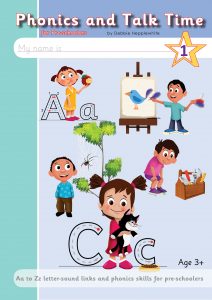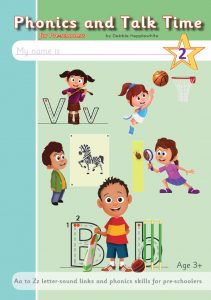Phonics and Talk Time books – for Pre-School/Nursery
Development
Debbie has been asked many times for guidance about early phonics for pre-schoolers – the three to five year old age range – that is, what to do PRIOR to introducing a full, systematic synthetic phonics teaching programme. Over a number of years, Debbie has liaised with advisors, teachers and parents to suggest and trial a phonics approach with the rationale of ‘exposure and experience – but with no particular expectation’ for the 3+ year olds.
In other words, with ‘no particular expectation’ about outcome levels, this is a pressure-free approach for beginning to introduce letter shapes and model the phonics processes of reading, spelling and handwriting to children. Debbie’s Phonics and Talk Time books support the parent and early years provider in the breakdown of the phonics skills into their sub-skills and how to introduce and practise these repetitively and cumulatively. This early explanation for how reading and writing works can be provided in both a ‘systematic way’ and an ‘incidental way’ – as the need and opportunities arise – drip-feeding the knowledge and skills required for lifelong foundational literacy.
Vocabulary enrichment and language comprehension:
Developing children’s language, however, is the most important aspect of all education that we can provide our children – thus Debbie emphasizes this in the title of her books and the language activities provided within them.
About the books:
The Phonics and Talk Time Book 1 and Book 2 introduce the pre-school child (3+ years) to the upper and lower case letter shapes of the alphabet linked to their smallest sounds of speech (phonemes). The letter-sound links are then used to introduce early reading, spelling and handwriting. Guidance is provided for the adult in the front cover notes and throughout the multi-skills activities pages – including for the essential ‘phonemic awareness’ activities of oral blending (a phonics sub-skill of reading) and oral segmenting (a phonics sub-skill of spelling).
In Book 1, activities are provided to tune children’s ear into hearing the first sound of spoken words, developing in Book 2 to isolating all the sounds from beginning to end of spoken words to enable early spelling. Becoming familiar with letter shapes not only by sight but also through letter formation linked to sounds helps to embed the skills of reading, spelling and handwriting. Adults guide the child in holding the pencil with the tripod grip and opportunities are provided for drawing and letter formation. Of course all this practice can be extended beyond use in the Phonics and Talk Time books.
Introducing capital letter shapes linked to sounds is often an aspect of early years and infant phonics provision that is least understood and sometimes neglected – and yet children are exposed to capital letters as much as lower case letters in environmental print (e.g. signs, posters, labels) and children’s literature – and, of course, their own name in print begins with a capital letter. It is also very important to emphasise the letter ‘sounds’ and not the letter ‘names’ so that children respond to any letter shapes with sounds – the requisite automatic response required for enabling reading and spelling new words. Too often, children responding to seeing letter shapes by their names can stand in the way of successful ‘sounding out and blending’ (synthesizing) for reading purposes.
Further, many children around the world are taught English as an additional language and the script in their mother tongue may be a different script from the Roman alphabet. The Phonics and Talk Time books feature all the letters of ‘the alphabet’ which is a very sensible way to introduce a new script to young beginners in such circumstances.
Review of the Phonics and Talk Time books:
“I really like the books. I particularly love the fact that you are encouraging children to recognise the capital letters alongside the lower case letters. This is something which I incorporate into my sessions as I was always amazed at the amount of children who came into KS1 not knowing all of their capital letters. I also love the comprehension questions which you have included (as we all know, comprehension is key!!). The bottom bars which encourage oral blending and segmenting are great guidance for practitioners and parents too.
The large pictures which encourage the children to find things beginning with the sounds remind me of the Oxford Reading Tree Floppy Phonics Sounds and Letters programme which we used on the interactive whiteboard, they are very eye catching and engaging. Will you be creating an app or anything to go alongside the books?
The progression between books is perfect. Parents will absolutely love these! I can see them in pre-school settings too, especially those attached to schools. One thing which I often come across in private day nurseries is that many members of staff can be unsure about how to pronounce the sounds correctly but then the same could be said for many parents! I like that you address the importance of pronouncing the sounds purely and provide guidance towards this.
One thought for nurseries and pre-school settings was whether there could be links to ideas for reinforcing learning in continuous provision (although that may be a whole book in itself!). I do think that a frieze would be good as it would be a constant visual reminder for the children.
Thank you so much for sharing these with me. Once they are published, I will happily recommend them to parents and nurseries.
I honestly think that the books are fantastic and will be extremely beneficial to parents and professionals.”
Rachel Naylor
Primary teacher, phonics advisor
Founder and Director of Active Phonics, see www.active-phonics.net
rachelnaylor@active-phonics.net
For more information and to enable full, transparent review of Debbie’s Phonics and Talk Time books, see this PowerPoint presentation:
(click the little double arrow [bottom right] to view in full screen)
See what’s in the books – view some sample pages from each of the 2 books!
Click the book cover image to view the contents.
Order page for single Phonics and Talk Time Book 1
Order page for single Phonics and Talk Time Book 2
Order page for single Phonics and Talk Time Books 1 and 2
Order page for 10 pack Phonics and Talk Time Book 1
Order page for 10 pack Phonics and Talk Time Book 2


